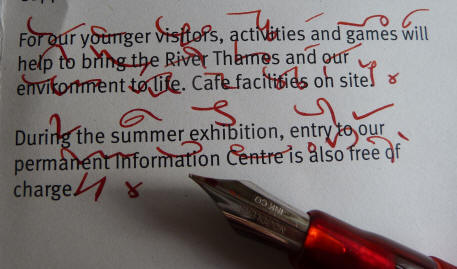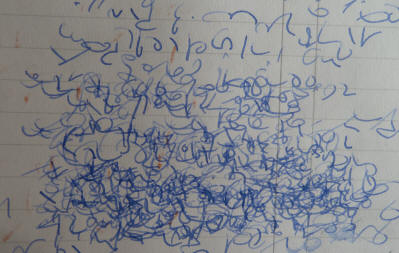|
Every shorthand
student wants the satisfaction of watching their hand zoom along the
line, producing all the correct outlines instantly, and then reading
it back without hesitation. Most advice that you will see from your web
searches will tell you to practise, practise, practise. This is
absolutely correct, as you will get nowhere if you just read and
mentally digest the theory chapters. You must get to the point
where the required outline jumps to mind without you having to
construct it from theory. The question to ask yourself is – what is
the purpose of this particular exercise or drill? I think you will
get the best results if you break your practising down into
different goals and approach each one with a separate method. There
are three main ways: facility
drills, dictation, and visualisation.
FACILITY DRILLS
are used to practise new outlines or phrases in isolation. Facility
means easiness and drill means doing the same thing over and over
again – repetition in order to make easier. It is helpful to write
the sample outlines in a different colour e.g. red ink, so that if
you do have to glance back at them, you can instantly locate them.
Once you have begun filling in the page, it becomes impossible to do
this rapidly if all the ink is the same colour. Use a soft red drawing pencil, suitably sharpened and
kept for this purpose only, or run a highlighter pen over the sample
line so that it stands out. Facility drills are used for the
following.
Familiarise
yourself with a new outline or phrase
Write each new outline on alternate lines in the margin, and then
copy them along all the blank lines. A line or two of each new word
is sufficient. Write it slowly and carefully several times, and then go
somewhat faster once your hand has become used to writing it.
Repeating single outlines is fine for when you first learn a new
one, but this rapidly becomes difficult as the mind tends to switch
off through lack of interest or variation, with the hand unable to
maintain control over the outline. You may also end up
writing the shape from memory without associating it with the word
it represents and, while this has some use in training the muscles
of the hand, it does not help much in learning the outline for
future use in dictation. If your hand starts to falter or sprawl,
move on to the next outline in the list.
Single outline drills are
necessary in the first chapter or two, but as soon as sentences or
short groups of words are possible, move over to those.
Learn new
outlines
Make up a line-length sentence containing several of the new
outlines surrounded by very simple ones that you already know. Copy
the line all the way down the page, speaking the words out loud or
mentally. After a few lines, you will be repeating the sentence from
memory and can look at your writing and not glancing at the sample
line. This is what a ready-made facility
drill book does for you, rather expensively it seems to me, but you
can make up your own, tailored to your own needs, at no cost other than your normal notepad. You must copy correct shorthand,
so using sentences from the instruction book is ideal. Keeping a
list of such
sentences in a separate file as well gives you instant revision
drill material.
Correct an
outline that you are consistently getting wrong
This needs to be a more severe drill because you are having to
unlearn what has become an incorrect habit. Fill a whole page with the correct outline, so that your hand is in
no doubt as to what it should be doing. When your hand or mind
starts to wander from the task, stop, change activity, and come back
to it later. Planting the recalcitrant outline in a short sentence
drill will provide the variation needed to keep your mind engaged on
the task.
Improve the flow
of your writing
Make up simple line-length sentences, preferably with lots of
phrases, and write at the top of each page of the pad. When you copy
this sentence all the way down the page, concentrate on an even
movement of the pen. Aim for a low consistent speed, not high speed,
with no change of pace from outline to outline and no stopping
between outlines. Glide from the end of one outline to the next. The outlines should be stroked
over the page, not dug or pressed into.

Make your own drill pages for single
outline/phrases, and sentences. Fill lots of pages with spaced out
sentences from your instruction book. With one sentence at the top,
you can also do a speed check - count the words in the sentence and
see how many times you can write it down the page in one minute.
Top of page
DICTATION
is your second line of attack, as it puts together everything you
have learned in the drills. There are several types, depending on
what you are aiming for.
Prepared
dictation
This method
enables you to absorb new outlines and gets you used to writing
from dictation, without being presented with
a stream of completely unknown outlines. You need to have the passage before you in correct
shorthand i.e. one of the exercises in your instruction book. Read it through several
times until you can read confidently with no hesitation. Write out the sentences one at a time and practise them. Any
hard or new outlines should get extra attention. Write out whole
passage as neatly as possible and then read from your own shorthand.
When you can read the shorthand passage from the book without
hesitation, read it out aloud but at the same time
recording it. You can now take this
dictation as it will be a reasonably easy speed, although writing it
is always somewhat harder than just reading. Practise any outlines
that you hesitated over. Read and record the passage slightly
faster, from the longhand key if necessary.
There is no need to calculate the
reading speed, but it is helpful to attempt to write at varying speeds,
getting faster and faster on the same passage. You might prefer to
read slowly with pauses at the end of each sentence, to give
yourself some catching up time. After the passage has been well
practised, aim to keep up with the spoken words and finish writing
as the speaker finishes. It is very satisfying to get to a pause and
not have to write anything because you have got it all down! The only speed
descriptions that you need to think about are “comfortable” and
“getting uncomfortable”!
Unprepared
dictation
– this is what all your shorthand learning is aiming for, taking
down speech with no knowledge of what is coming next. During any
dictation you are doing at least three things – listening to the
word, recalling the outline and writing it – all simultaneously, as
you are dealing with the next few words whilst still writing the
previous ones. These too should be done at varying speeds so that
you do not get either lazy from too many slow ones, or unduly
discouraged from too many fast ones. An unprepared dictation will
not teach you any shorthand, but it will train your mind to retrieve
outlines rapidly and show up whether your concentration on the task
needs some strengthening. Obviously you cannot retrieve an outline
that you don’t know, but you can write parts of it or some of the
consonants. As you read back your notes, mark up the gaps and
errors, and work on them, then retake the passage. Recording a batch in advance
should give you a chance to forget the content.
Slow or easy
dictations
enable you to concentrate on neat writing (something that often gets
left behind in the headlong rush for high speed). If prepared, you
can concentrate on neat flowing writing. If unprepared, you can gauge
your skill in recalling outlines without too much pressure. This will also help with gaining the
skill of remembering what has been said, whilst writing the current
outline.
Fast dictations
put all your learning together into a situation that approaches the
final use that you will be making of shorthand. What they show up is
how your mind is reacting to the situation, whether you panic and
freeze up, or whether you can maintain control and press on. It is a
battlefield where you see what you are capable of, but it is not
going to teach you any actual shorthand. They keep the writer alert
and in a swift frame of mind, but they should be greatly outnumbered
by the prepared ones, which are filling your mind with the correct
shorthand that you will need when the fast dictations are
undertaken.
Silent
dictations
can be done by
writing the shorthand over the top of the text in a newspaper,
magazine or leaflet. This will help you practise recall of outlines,
but to get most benefit you should say the words to yourself, either
out loud, whispered, or at least heard mentally. Such an exercise is
ideal for when you are in public or do not have your shorthand
materials with you – in the
park, during lunch hour at the office or college, in a library or
waiting room. Draw a ring round any words that need later attention.


Squeezing the last bit of use out of leaflets
before recycling the paper. Catalogs are especially good as they
repeat the same words and phrases on many of the pages.
Top of page
VISUALISING
means listening and imagining the outlines being written on
imaginary paper. This allows you to practise just one part of the
whole process – recall of outlines – without being hampered by all
the other parts, such as writing, moving from line to line, turning
the page, doubts about being able to read it back, or the
duration of the dictation. With a strong will, you can do very well
on matter that would be too fast if being written, and I
think the reason for this is that it avoids the insidious and
unhelpful habit of glancing at what you have just written and
worrying about the state of the outlines. This exercise can be done anywhere
where you can safely give attention to the words being spoken in
your hearing – on a bus, in a queue, television, radio, etc.
A
useful extension to this method is to have a large piece of paper
and, with eyes shut, write the shorthand that you are visualising.
Write along the paper and then go back to the beginning for the next
“line”, keeping to your normal line length. The idea of having a big
piece of paper is so that you do not worry about falling off the
edge of a pad. The shorthand will be an unreadable scribble written
on top of itself. You can get the same effect
by pretending to write, with a capped biro or the wrong end of a
pencil, on a newspaper or even the table top, as there are still no actual
outlines visible to distract you. You can either use spoken words,
or recite to yourself a favourite song or poem. To avoid the
frustration of unknown outlines occurring during visualisation, it is helpful
to keep some paper handy to jot down any words you wish to look up
later, although this must not become a ruse to interrupt the flow.

Maybe it's better not to look at the results!
Visualising the
shorthand can be quite a revelation of just how much of speed
difficulties are caused by your mind pondering and fretting over
what you have already written and generally getting in the way of
what should be the simple task of recalling a stream of outlines to match the
words. These internal distractions are just as bothersome and
intrusive as external ones, causing you to fall behind and stealing from you outlines that you know very well but just don’t have
time to write.
My shorthand teachers used
all these methods, although at the time we merely did as they
requested us to do, without particularly wondering about the reasons
behind the methods. They
always gauged the dictations so that we were encouraged,
not discouraged, with a mixture of speeds and levels of difficulty.
Most passages
were done at least twice, with time for corrections and questions in between,
and we were expected to read back the last dictation at home, to
save precious lesson time.
After college, when attempting to increase speed, I
spent more time thinking about the best way to demolish each type of
problem, and so my approach to the subject became a bit more
focused.
There are many ways to
practice shorthand, but the important point is to identify what is
being aimed for and target the activity to achieve it. Piecemeal
successes not only add up over time, but also bring a sense of
ongoing achievement that contributes greatly to one’s determination
to continue with the subject. Just like
other types of study, training, or even gardening or housework, if
you tackle one type of challenge or job at a time, I believe you
will be giving yourself the best chance of success.
Read a condensed version of this page written in
shorthand on:
http://www.long-live-pitmans-shorthand-reading.org.uk/blog-pages/blog-2012-10.htm#How_To_Practise
Top of page
|